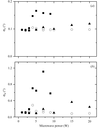issue contents
February 2005 issue

Cover illustration: Optical anisotropy, |sin ![[delta]](/logos/entities/delta_rmgif.gif) |, image of a cryocooled 2F1 3F1 human fibronectin crystal taken using a birefringence microscope that allows quantitative measurements. A correlation has been observed between the slow optical axis position (SOAP) and the diffractive quality of room temperature and cryocooled protein crystals (p. 130).
|, image of a cryocooled 2F1 3F1 human fibronectin crystal taken using a birefringence microscope that allows quantitative measurements. A correlation has been observed between the slow optical axis position (SOAP) and the diffractive quality of room temperature and cryocooled protein crystals (p. 130).
research papers
A novel screening strategy and a simple modification of hardware have improved throughput for obtaining quality crystals for X-ray diffraction analysis.
Open  access
access
 access
accessA polarizing light microscope is used to assess quantitatively the optical quality of protein crystals. This optical quality is then compared with the diffraction quality of the crystals and found to be correlated.
The crystal structure of P. aeruginosa Hfq protein has been determined at 1.6 Å resolution.
Structural data are reported to 2.5 Å resolution for the methotrexate-resistant L22R variant of mouse DHFR as a ternary complex with methotrexate and NADPH. Comparison of these data with the L22R variant of human DHFR and the wild-type mouse and human DHFR ternary complexes reveals that the active site of the mouse enzyme is larger than the human enzyme.
The crystal structures of R- and T-state hemoglobin Bassett suggest a stereochemical basis for the unusual functional properties of this hemoglobin.
Atomic mean-square displacements in tetragonal hen egg-white lysozyme crystals exposed to strong microwave fields are used as a probe for non-thermal microwave effects on protein dynamics. Results show that the effect of microwaves is largely thermal and determined by the heating of the crystal water by the microwave radiation.
Crystals of panicum mosaic virus have been grown and analyzed by X-ray diffraction and atomic force microscopy techniques. The virus particles were found to pack in a pseudo-face-centered cubic arrangement in space group P21, with two particles per asymmetric unit.
The mutation from Phe58 to Trp58 of cytochrome b5 leads to difficulty in growing single crystals and results in multiple conformations of several side chains and weakens the stacking interactions with heme and the axial ligand His63.
short communications
Open  access
access
 access
accessThe three-dimensional structure of the B. halmapalus family GH13 α-amylase in complex with acarbose is reported at 2.1 Å resolution. The study reveals an unusual transglycosylation-derived nonasaccharide.
PDB reference: BHA–nonasaccharide complex, 1w9x, r1w9xsf
Open  access
access
 access
accessThe crystal structures of three different complexes (methyl syringate, methyl sinapinate and methyl vanillate) of the feruloyl esterase module derived from the C. thermocellum xylanase 10B are reported at 1.4 Å resolution. The substrates bind in a small depression on the surface of the enzyme that contains specific determinants for both the m-methoxy and the p-hydroxyl ring substituents.
A model for the twinned crystals of native methylenetetrahydromethanopterin dehydrogenase (Mtd) was derived from the structure of the Se-methionine labelled Mtd crystals by group–subgroup relations. The static changes found in the refined new structure are consistent with the striking anisotropic libration of the molecular moieties established by TLS refinement for Mtd-Se crystals.
FibreHelix, a program for calculating the X-ray diffraction patterns of fibres of macromolecules with helical symmetry, is presented. It is particularly useful for visualizing the diffraction pattern of coiled coils.


 journal menu
journal menu




























